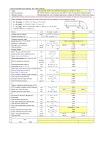
In Piping System the Flange gaskets are used to create a static seal between two flanges faces, at various operating conditions, with varied pressure and temperature ratings. A gaskets fills the microscopic spaces and irregularities of the flange faces, and then it forms a seal that is designed to keep liquids and gases. Every standard gasket comes with its own set of properties. However, gasket properties can be enhanced with a combination of various materials.
Let’s take a look at the different types of gaskets :-
- Non-metallic Gaskets
- Metal Gasket
- Semi-metallic types

Non-metallic gaskets also called soft gaskets are easily compressed under bolt load. Non- Metallic Gaskets are used in a large range of applications such as pipe flanges, heat exchangers, compressors, and bonnet valves. It can be bought in a variety of cut shapes or be found in sheet or rolls. Non-metallic gaskets are usually composite sheet materials are used with flat-face and raised-face flanges in low Pressure Class applications.
Non-metallic gaskets are manufactured from fiber, glass fiber, elastomer, Teflon (PTFE), graphite etc.. Full-face gasket types are suitable for use with flat-face flanges. Flat-ring gasket types are suitable for use with raised face flanges.
Applications :-
- Since they don’t contain metal, they offer superior corrosion resistance, but can only handle a limited range of temperature and pressure.
- These gaskets are available in a variety of cut shapes.
- They are used in large number by various industries and in a variety of applications, especially when low and medium sealing conditions are applied..
- These types of gaskets are used with low-pressure class flanges such as 150 and 300 Class and also in low-temperature However, graphite gasket can be used up to 500 Degree centigrade.
- Rubber and elastomer gaskets are not used in hydrocarbon services but used in utility lines.
- Non-Metallic gaskets are cheapest and easily available.
2.Metal Gaskets :-

Ring Type Joint gaskets are designed to seal by "initial line contact" or wedging action between the mating flange and the gasket. By applying pressure on the seal interface through bolt force, the "softer" metal of the gasket flows into the micro fine structure of the harder flange material, and creating a very tight and efficient seal.
3.Semi Metallic Gaskets :-

Semi Metallic Gaskets are also called as Composite Gaskets. These gaskets can be multi-layer gaskets with multiple inserts made of metallic and/or non-metallic materials.
Here are the some of the Types of Semi Metallic Gaskets :-
- Spiral wound gaskets
- Cam Profile gaskets
- Metal jacketed gaskets

- The spiral wound gasket meets the most exacting conditions of both temperature and pressure in flanged joints and similar assemblies and against every known corrosive and toxic media.
- The spiral wound gasket depends upon the mechanical characteristics of a formed metal spiral strip, rather than the compressive virtues of more traditional gasket materials.
- The sealing strips, or fillers, are usually graphite, although other materials such as Teflon may be used, the windings are always stainless steel
- The completed gasket is fitted into a steel ring of specific thickness. When the gasket is fitted into a flange and the bolt load is applied, flange closure is governed by the outer steel ring of the gasket.
* Cam Profile or Grooved Gaskets :-

- Cam Profile or "Grooved" gaskets have proven themselves in all industrial applications.
- Cam Profile gaskets are found in industrial power plants and in the primary circuits in nuclear installations
- Cam Profile gaskets are made from a solid serrated metal core faced on each side with a soft nonmetallic material
- The term Cam Profile (or kammprofile) comes from the groove profile found on each face of the metal core (groove profile shown in figure)
- Cam Profile gaskets consist of a metal core (generally Stainless Steel) with concentric grooves on either side with sealing materials. The sealing layers (depending on the service duty) can be Graphite, Teflon, or Metal (e.g. Aluminium or Silver).
- Camprofile's can be used without sealing layers to provide an excellent seal but there is a risk of flange surface damage
- The Cam Profile gasket combines the strength, blowout, and creep resistance of a metal core with a soft sealing material that conforms to the ange faces providing a seal.

- Jacketed gaskets are made from a nonmetallic gasket material enveloped in a metallic sheath
- This inexpensive gasket arrangement is used occasionally on standard ange assemblies, valves,
- and pumps.
- Jacketed gaskets are easily fabricated in a variety of sizes and shapes and are an inexpensive
- Metal Jacketed gaskets require smooth flange surface finishes, high bolt loads and flange flatness in order to seal effectively.
Gaskets Materials and Applications












-page-001.jpg)


0 Comments